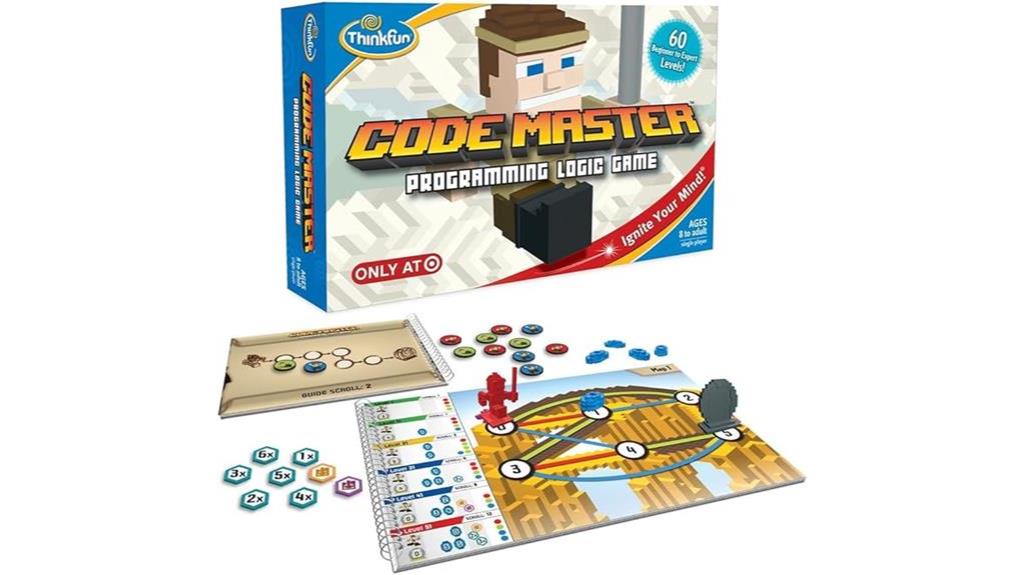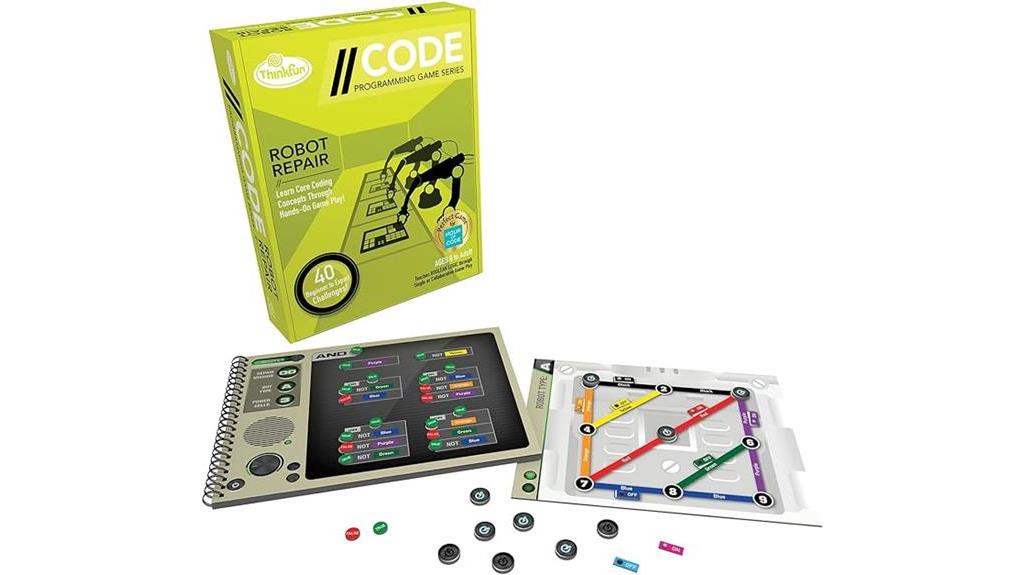Budding programmers and seasoned coders alike can discover a delightful dimension to developing their skills through board games. You're probably aware that programming logic is essential, but you might not have considered how the strategic play of certain board games can sharpen these skills in a fun and engaging way.
From the challenge of navigating a robot through puzzles to mastering the intricacies of artificial intelligence, these six board games offer a unique blend of entertainment and education. As you explore these options, you'll find valuable insights on how each game can cater to different learning styles and programming levels, ensuring there's something for everyone.
Why not discover which game might unlock your or someone else's coding potential?
ThinkFun Code Master Programming Logic Game (STEM Toy)

If you're looking for a fun way to dive into programming logic, the ThinkFun Code Master Programming Logic Game is an ideal choice for kids and adults alike. This engaging STEM toy doesn't just entertain; it educates by teaching essential programming principles through captivating gameplay.
You'll navigate through 10 maps and 60 levels, using 12 guide scrolls, 12 action tokens, and 8 conditional tokens. The game's designed to develop critical skills like reasoning and planning, offering a stealthy learning experience that feels more like play. With challenges ranging from beginner to expert, it's perfect for building planning, sequential reasoning, and problem-solving skills. Plus, it's supported by over 50 million families worldwide and has bagged several awards, making it a trusted educational tool.
Suitable for ages 8 and up, it promises to be a hit with smart kids and curious adults eager to explore the basics of coding logic without staring at a screen.
Best For: Kids and adults interested in learning programming logic in a fun and interactive way.
Pros:
- Engages players in learning programming concepts without the need for screens.
- Offers progressively challenging levels to suit beginners to expert learners.
- Encourages development of critical thinking, planning, and problem-solving skills.
Cons:
- Limited replay value once all levels are completed.
Think Fun Robot Repair Coding Board Game (STEM Toy for Ages 8 and Up)

For kids aged 8 and up, the Think Fun Robot Repair Coding Board Game emerges as an ideal STEM toy, blending the excitement of gameplay with the foundational skills of programming. With over 50 million products sold, it's trusted by families worldwide. It comes packed with 4 robot circuit boards, 40 challenges from beginner to expert levels, tokens, and an easy-to-follow instruction manual. It's not just about fun; it's about developing critical skills such as reasoning, planning, and core programming principles.
Though opinions vary, with some finding it easy and questioning its educational value, others laud its engagement and recommend it for elementary students. Despite these mixed reviews, it stands out as a game that offers engaging challenges for young minds fascinated by programming.
Best For: Kids aged 8 and up interested in learning programming concepts through interactive play.
Pros:
- Develops critical reasoning, planning, and core programming skills.
- Includes multi-level challenges that cater to beginners through to experts.
- Encourages storytelling and imagination, making learning fun and engaging.
Cons:
- Some users find the game too simple and lacking in complexity.
Think Fun Hacker Cybersecurity Coding Game (STEM Toy for Ages 10 and Up)

Kids eager to dive into coding will find the Think Fun Hacker Cybersecurity Coding Game an engaging and educational choice, teaching core programming principles through hands-on challenges. Trusted by families globally with over 50 million products sold, this game not only sharpens reasoning and planning skills but also introduces kids to the intricacies of core programming principles.
You'll navigate through 120 increasingly difficult challenges, honing logical, spatial reasoning, and planning skills. It's perfect if you love smart games and puzzles. The game's size and weight make it a substantial gift, and with a 4.4-star rating from 693 reviews, it's clear players find it both challenging and enjoyable. Plus, it's screen-free, making it a great way to learn coding concepts and cybersecurity basics while having fun.
Best For: Kids aged 10 and up who are interested in coding, cybersecurity, and enjoy challenging logic puzzles.
Pros:
- Develops critical skills in reasoning, programming principles, and planning.
- Offers 120 challenges of increasing difficulty to keep the gameplay engaging and educational.
- Provides a screen-free way to learn coding concepts and cybersecurity basics.
Cons:
- Some users find the game complicated, which mightn't suit younger children.
AI Learners Board Game: Teaches AI and Programming

Designed by a 9-year-old prodigy, Coder Mindz stands out as the perfect choice for anyone looking to dive into the world of AI and programming through interactive board gameplay. This game, celebrated by over 100 media outlets and used in 600 schools globally, makes complex AI concepts like image recognition and adaptive learning accessible. You'll navigate through coding challenges using cards, making each play both strategic and engaging.
Whether you're at home or in a coding club, Coder Mindz adapts to various skill levels, ensuring everyone from kids to adults can enjoy and learn. It's not just a game; it's a fun, educational journey into the future of technology, preparing you for an AI-driven world.
Best For: Families and educators seeking a fun and interactive way to introduce children to the concepts of coding and artificial intelligence.
Pros:
- Engages children in STEM learning through interactive and strategic gameplay.
- Adaptable to different skill levels, making it accessible for a wide age range.
- Enhances understanding of AI and coding concepts in a simplified, enjoyable manner.
Cons:
- May require guidance for younger children to fully grasp complex concepts.
Coder Bunnyz STEM Coding Board Game

If you're looking to introduce a child to the fundamentals of coding, the Coder Bunnyz STEM Coding Board Game stands out as an engaging and educational choice. Designed for ages 4 to 104, this game makes learning coding concepts accessible and fun. You'll program Bunnyz with Code Cards to navigate through mazes, reaching destinations while mastering both basic and advanced coding principles.
Created by a 9-year-old, Samaira, and celebrated by educational institutions, Coder Bunnyz has been used to teach over 4800 kids at Google, showing its widespread recognition and effectiveness. It's ideal for anyone starting their coding journey, offering a hands-on experience that enhances problem-solving and strategic thinking skills without needing any prior coding knowledge.
Best For: Families or educators looking for an engaging way to introduce children to coding concepts.
Pros:
- Teaches both basic and advanced coding concepts in an accessible way.
- Recognized by educational institutions and has widespread use, including at Google.
- Offers different levels of play to accommodate various skill levels and ages.
Cons:
- Some users find the game too simplistic for older children or those with prior coding experience.
CoderMarz Board Game for Space and AI Learning

For those seeking an engaging way to learn about Mars, coding, and AI, CoderMarz offers a high-quality, educational experience. Invented by 11-year-old Samaira, this board game has caught the attention of over 100 media outlets for its innovative approach to STEM learning. It's perfect for a variety of settings, from homes to coding clubs.
As you explore Mars, collecting resources and navigating towards your home base, you'll dive into Mars Plains, Mountains, Rovers, and AI concepts, all while mastering both basic and advanced coding principles. The game's wooden astronaut meeples, resource tokens, and volcano tiles, along with its well-thought-out gameplay mechanics, ensure an immersive learning adventure. With simple rules and different difficulty levels, CoderMarz is accessible to players of all ages and skills.
Best For: Families and educational institutions looking for a fun and interactive way to introduce children to coding, AI, and space exploration.
Pros:
- High educational value, teaching both basic and advanced coding along with AI concepts and Mars exploration.
- Inventive gameplay that encourages strategic thinking and problem-solving skills.
- Versatile usage across various settings such as home, schools, and clubs, making it accessible to a wide audience.
Cons:
- Limited player interaction may not appeal to those seeking a highly competitive or collaborative gaming experience.
Factors to Consider When Choosing Board Games for Teaching Programming Logic

When you're picking out board games to teach programming logic, it's crucial to weigh several factors.
Consider if the game's content is suitable for the player's age, its educational value, and how complex it's to play.
Also, look into how interactive the gameplay is and whether it has enough depth to encourage multiple playthroughs.
Age Appropriateness
Selecting the right board game for teaching programming logic requires careful consideration of its age appropriateness to match the player's developmental abilities. Always check the recommended age range on the packaging to ensure it aligns with the player's stage of development. Age appropriateness significantly impacts the complexity of gameplay and the cognitive skills required.
Younger children need simpler mechanics and clearer instructions tailored to their age group, while older players may find more challenging puzzles and abstract concepts in programming logic engaging. By matching the game's complexity to the player's age, you'll not only enhance their learning experience but also ensure they're having fun.
This careful selection ensures that the game is both an educational tool and a source of enjoyment.
Educational Value
After ensuring a board game matches the player's age, it's crucial to assess its educational value in teaching programming logic. You'll want a game that offers a structured approach, making sure it not only entertains but also educates.
Look for games that provide a clear understanding of programming principles. This means choosing ones that encourage critical thinking, problem-solving, and sequential reasoning skills. It's vital the game introduces coding basics in a way that's both fun and engaging, enhancing the learning experience.
Make sure the game aligns with the player's skill level as well, as this will maximize educational benefits and ensure the concepts are neither too simple nor too complex.
Game Complexity
Understanding the complexity level of a board game is crucial as it ensures the game matches the player's ability, fostering both challenge and learning in teaching programming logic. It's essential to consider the age and skill level of the players.
You'll want a game that offers a progression of difficulty, ensuring that beginners can start comfortably while more experienced players still find it engaging. Assess if the game introduces advanced concepts like conditional statements or loops, as these are pivotal for in-depth learning.
Always aim for a balance, avoiding games that are too simplistic or overly complex, which allows players to gradually improve. Lastly, checking reviews or recommendations can be invaluable in determining a game's effectiveness in teaching programming logic at varying levels of complexity.
Interactive Gameplay
When choosing board games to teach programming logic, you should zero in on those with interactive gameplay to maximize engagement and learning. Interactive gameplay engages you by demanding active participation in solving challenges. It encourages hands-on learning as you make decisions and solve problems.
You'll interact with game components, follow rules, and make strategic choices to progress. Elements like tokens, cards, and boards create a dynamic gaming experience. This active involvement in gameplay helps you grasp programming concepts and logic principles more deeply. It's not just about moving pieces on a board; it's about thinking, planning, and executing strategies that mirror real programming scenarios.
Interactive gameplay turns learning into an engaging, participatory experience.
Replayability Factor
One crucial factor to consider in selecting board games for teaching programming logic is their replayability, as it significantly enhances learning by offering diverse challenges and scenarios. Games with high replayability keep you engaged by continuously providing new puzzles and levels of difficulty. This ensures that you're not just memorizing solutions but truly understanding the underlying programming concepts.
With customizable content, these board games adapt to your growing skills, making every play session a unique opportunity to learn. Replaying a game allows you to reinforce your grasp on programming logic, tackling problem-solving situations from different angles. The long-term educational value of a board game with a high replayability factor can't be overstated, offering endless opportunities for mastering coding concepts while keeping the learning process exciting and fresh.
Learning Curve
Assessing the learning curve of a board game is essential, as it should offer a smooth transition from basic to more complex programming principles. When choosing a board game for teaching programming logic, you need to ensure it starts with simple concepts. Gradually, it should introduce more complex logic, allowing players to build on their knowledge.
It's crucial to find games that provide clear instructions and tutorials, making new concepts accessible. Also, check if the game includes opportunities for practice and reinforcement before advancing. You're aiming for a game that strikes the perfect balance between challenging the players and keeping them engaged, ensuring a productive learning experience without overwhelming them.
Component Quality
After considering the learning curve, it's also crucial to evaluate the quality of components in board games aimed at teaching programming logic. High-quality components not only enhance the overall gaming experience but also contribute to the game's durability.
Durable tokens, cards, and game pieces mean your game will last longer, even with frequent play. Quality meeples and wooden components can add a tactile and premium feel, making the game more engaging and enjoyable. Additionally, well-crafted components can withstand wear and tear, ensuring that the game remains in good condition over time.
The material and construction of these components significantly impact the game's value and your enjoyment. So, don't overlook the quality of components when choosing a board game for teaching programming logic.
Frequently Asked Questions
How Can Parents With No Programming Experience Learn Alongside Their Children Using These Board Games?
You can learn alongside your kids by playing these board games together. They're designed to be intuitive, so you'll pick up programming logic as you go, making it a fun learning experience for both.
Are There Any Mobile Apps or Online Resources That Complement These Board Games for Enhanced Learning?
Yes, you'll find several mobile apps and online resources that pair well with these games. They'll deepen your understanding and skills, making the learning process even more engaging and effective for both you and your kids.
How Do These Games Adjust to Different Learning Speeds, Especially for Younger Children Who Might Find Certain Concepts Challenging?
These games often include adjustable difficulty levels and step-by-step challenges, allowing you to tailor the experience to your child's pace. They're designed to grow with their skills, ensuring they're always appropriately challenged.
Can These Board Games Be Effectively Used in a Classroom Setting, and if So, What Are the Best Practices for Educators to Integrate Them Into Their Curriculum?
You can effectively use these games in your classroom by aligning them with lesson objectives and incorporating team challenges. It's crucial to adapt gameplay to fit your curriculum and engage students at different skill levels.
Are There Community Events or Competitions Centered Around These Board Games Where Kids Can Showcase Their Skills and Learn From Others?
Yes, there are community events and competitions where you can showcase your skills and learn from others. They're great for socializing and improving your abilities by observing and interacting with fellow enthusiasts.
Conclusion
You've got a fantastic lineup of board games to choose from, each designed to sharpen your programming logic while ensuring you have a blast.
From mastering coding basics with ThinkFun's engaging offerings to exploring AI with AI Learners and CoderMarz, there's something for every aspiring coder.
Remember, when picking the perfect game, consider the player's age, interests, and skill level.
Dive into these games and turn your coding learning journey into an exciting adventure.
Happy coding!




Leave a Reply